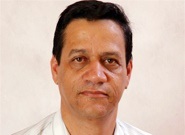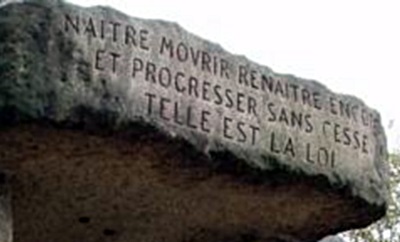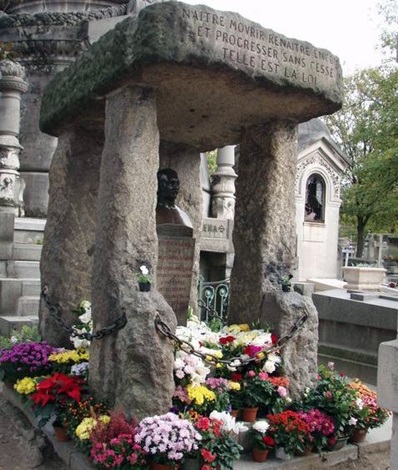 |
|
Paulo da Silva Neto Sobrinho |
|
|
|
|
Phrase
attributed
to
Kardec:
“To be
born,
die, to
be born
again,
and
progress
constantly,
that is
the law” |
It is
not
uncommon
to hear
Spiritist
speakers
mention
that
Kardec
is the
author
of that
famous
phrase.
We have
tried to
find out
from
some of
them
which
were
their
sources
to this
information
they
passed
to the
public,
but we
never
had
success.
So our
option
was to
make a
thorough
research
on all
the
Encoder’s
works to
see if
we could
find
something.
But we
found
nothing
about
it. And
we have
no hope
to find
it one
day.
Well,
Jesus
said
that
"there
is
nothing
hidden
that
will not
be
revealed,
and
there is
nothing
hidden
that
will not
become
known"
(Mt
10.26;
Lk 12,
2). And
today
there
was
light
and we
finally
found a
book
that
mentions
this
sentence.
It is
the book
Allan
Kardec:
the
Educator
and
the
Encoder,
by Zeus
Wantuil
and
Francisco
Thiesen,
published
by the
Brazilian
Spiritist
Federation.
Since we
are of
the
opinion
that
this
work can
certainly
clarify
the
matter,
and
consequently,
point
out its
origin,
we
decided
to copy
the
following
passage:
On the
front
edge of
the
stone
weighing
six tons,
and
which
serves
as the
ceiling,
there is
the
phrase
that
defines
Kardec’s
Doctrine,
of
justice
and
progress:
NAÎTRE,
MOURIR,
RENAÎTRE
ENCORE
ET
PROGRESSER
SANS
CESSE
TELLE
EST LA
LOI

This
inscription
was
missing
at the
time of
the
opening,
having
been
carved
in 1870
(39).
Jean
Vartier,
who
wrote
part of
Kardec’s
biography
(40),
informs
that the
phrase
was
modeled
in
Chapter
IX
of the
first
part
of the
book "Die
Wahlverwandstschaften"
by
Johann
Wolfgang
von
Goethe.

Vartier
based
himself
on the
French
translation
of
Camille
Selden,
Elise
Krinitz
pseudonym,
published
in
Paris,
s.d.,
with a
preface
dated
January
1872. In
fact, in
the
mentioned
translation
- "Les
affinités
electives"
- on
page 78,
there is
reference
to a
house
that had
its
foundations
beginning.
At the
ceremony,
a
Mason,
with the
hammer
in one
hand and
a spoon
in the
other,
tried to
say in a
small
speech
that the
building
being
raised
would
one day
be
destroyed,
adding,
“Born to
die, die
to
reborn,
that is
the
universal
law. Men
are
subject
to this,
the
strongest
reason
for
their
work”.
Mr.
Vartier
with his
quick
and
critical
thinking
should
have
studied
the
subject
more
thoroughly.
He would
have
then
discovered
that in
the
original
German
there is
the same
phrase,
as it is
in
French;
that the
French
translation
made
with
certain
freedom
by C.
Selden,
was
published
subsequently
to
January
1872,
over a
year
after
this
maxim
was
engraved
on
Kardec’s
dolmen;
and that
if there
was
plagiarism
(as Mr.
Vartier
tried to
imply),
it came
from the
translator.
We do
not
believe,
however,
in
plagiarism
from
anyone.
The
phrase
in focus
was in
the air,
it does
not
belong
to
Kardec
as some
claim,
and it
can be
found
with
some
variations
in
quotes
much
before
Kardec’s
death,
for
example,
in the
book
"Clé de
la Víe"
by Louis
Michel,
organized
by C.
Sardou
and L.
Pradel,
editors,
Rue du
Hassard,
9,
Paris,
dated
August
1, 1857,
page
570:
“Saturées
de
l'aimant
divin,
de
l'amour
divin,
des
provisions
divines
de toute
nature,
les âmes
solaires,
par cet
aimant,
par cel
amour,
par tous
ces
divers
agents
cêlestes.
font
naître,
vivre,
circuler,
évolutionner,
mûrir,
se
transformer,
monter
au
chemin
ascendant,
leurs
soleils
et leurs
planètes,
et, par
les âmes
de ces
dernières,
font
jouir
des
mêmes
avantages
la plus
obscure
image de
Dieu
elle-même,
l'homme,
restê,
encore,
en
dehors
de
l'unité;
dès
qu'il
consent
à s'y
prêter
un peu”.
In a
speech
in the
presence
of
Kardec,
on
14
October
1861,
at
the
General
Meeting
of
Spiritists
of
Bordeaux,
Mr.
Sabo
said
verbatim:
“...pour
aller à
lui, il
faut
naître,
mourir
et
renaître
jusqu'à
ce qu'on
soit
arrivé
aux
limites
de la
perfection...”
(“Revue
Spirite",
1861, p.
331.)
Let us
also see
these
two
sentences:
"Tout,
tout,
dan
cette
grande
unité de
la
création,
existe,
naît,
vit,
fonctionne
et meurt
et
renaît
pour
l'harmonie
universelle".
“(...)
il faut
naître,
mourir
et
renaître
jusqu'à
ce que
l'on
soit
parvenu
aux
limites
de la
perfecion”.
They are
found in
“Les
Quatre
Évangiles”,
J. B.
Roustaing,
Tome
Premier,
Paris,
Librairie
Centrale,
24,
Boulevard
des
Italiens,
1866,
pages
191 and
227,
respectively.
We note
that
the
phrase
is
substantially
the same,
in
various
forms,
always,
however,
with the
same
sense,
in 1857,
1861,
1866 and
finally
in 1870,
when it
was
carved
on the
frontispiece
of the
dolmen
of
Kardec,
in three
lines:
NAÎTRE,
MOURIR,
RENAÎTRE
ENCORE
ET
PROGRESSER
SANS
CESSE
TELLE
EST LA
LOI
Was it
due to
all this
that the
Spirit
Emmanuel
did not
attribute
it to a
particular
human
being,
but to
Spiritism?
Indeed,
he says,
on the
page
entitled
"Trouble
with
us,"
inserted
in the
book "Divine
Justice"
(FC
Xavier,
FEB
3rd
edition,
1974,
page
84):
"And
Spiritism
emphasizes:"
To be
born,
live,
die,
to
be born
again
and
constantly
progress,
that is
the Law".
(italics
are ours
[the
authors]).
______
(39)
“Speech
pronounced
at the
anniversary
of Allan
Kardec’s
death.
Inauguration
of the
monument”,
Paris,
Spiritist
Library,
1870,
pages
7-8. To
this
work a
print of
Kardec’s
dolmen
was
attached,
“performed
with the
utmost
care by
Mr.
Pegard,
engraver,
according
to a
drawing
made by
Mr.
Sebille”
(pages
11 and
12).
Pegard,
a
woodcutter
of the
French
school
authored
the
images
of the "Dictionnaire
d'architccture"
by
Viollet-le-Duc
and
those of
“Histoire
populaire,
anecdotique
et
pittoresque
de
Napoléon”.
(Apud
E.
Bénézit:
“Dictionnaire
des
Peintres,
Sculpteurs,
Dessinateurs
et
Graveurs”,
new
edition,
6th,
Gründ
Library,
1996,
page
571.)
(40)
Jean
Vartier:
“ALLAN
KARDEC,
la
naissance
de
Spiritisme”,
Paris,
Libraire
Hachette,
1971,
pages
150/151.
(WANTUIL,
Z. and
THIESEN,
F.
Allan
Kardec:
the
Educator
and
the
Encoder.
Vol.
II.
Rio de
Janeiro:
FEB,
2004, p.
285-288,
emphasis
added).
Considering
it
opportune
and
answering
a
request
from a
friend,
we copy
the
translation
of the
phrases
in
French,
contained
in the
Revue
Spirite
and
Les
Quatre
Evangiles,
in
order:
[...] To
go to
him, you
must be
born,
die and
be born
again
until
you have
reached
the
limits
of
perfection,
[...]
(Kardec,
A.
Spiritist
Magazine
1861.
Araras,
SP: IDE
1993:
331).
Everything,
everything,
in the
great
unity of
Creation,
is born,
exists,
lives,
works,
dies and
is
reborn
to the
harmony
of the
universe,
[...] (Roustaing,
JB
The four
Gospels
-
revelation
of
revelation
Vol 1.
Rio de
Janeiro..:
FEB s /
d., p.
323).
[...] To
get to
him, man
would be
born,
die and
be
reborn
until he
reaches
the
limits
of
perfection.
[...] (Roustaing,
JB
The four
Gospels
-
revelation
of
revelation
Vol 1.
Rio de
Janeiro:
FEB,
s.d.
page
387).
It is
clear,
therefore,
that the
phrase
is not
even
Kardec’s.
Not
placing
ourselves
above
all
others,
we
sincerely
hope
that the
information
hereby
presented
has
contributed
to the
clarification
of our
speakers
on the
matter.
We
thought
the
matter
was
already
concluded;
however,
through
information
from a
friend,
a
student
of the
Doctrine,
we found
something
concrete
in Leon
Denis
(1846-1927),
in his
work
The
problem
of
being,
of fate
and pain
(Rio de
Janeiro:
FEB,
1989),
from
which we
quote
"'To be
born,
die, be
born
again,
and
progress
always,
this is
the
law",
said
Allan
Kardec
"(page
272,
emphasis
added)
without
ever
mentioning
from
which
work of
the
Encoder
did he
copy
this. We
recognize
that, in
fact,
the
phrase
may well
represent
the
thought
of
Kardec,
but from
what we
saw in
Wantuil
and
Thiesen,
it was
not said
by him.
The lack
of
information
can lead
us to
repeat
something
that the
person
never
said, as
for
example,
with
Leon
Denis
himself.
The
following
phrase
is
attributed
to him:
"The
soul
sleeps
on the
stone,
dreams
in the
plant,
stirs in
the
animal
and
wakes up
in man”.
But
Denis,
in his
aforementioned
work,
wrote: "In
the
plant,
the
intelligence
rests;
in the
animal,
it
dreams;
only in
the man
does it
wake
up".
(page
123,
emphasis
added),
which we
must
agree,
it is
not the
same
thing.
Therefore,
we do
not
doubt
that
Leon
Denis
also
assigned
the
phrase
to
Kardec
using
the same
pattern
that
many
Spiritist
schollars
are
using
regarding
Denis
himself.
In fact,
he was a
follower
of the
Doctrine
of the
Spirits
for only
five
years
when
Kardec
died.
Thus, he
was
still a
new
convert.
|